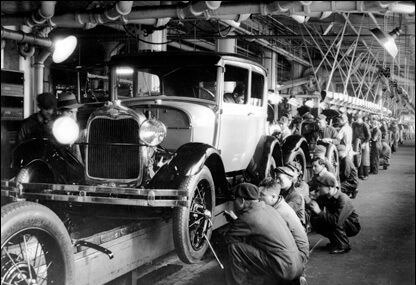 With the advent of electricity and new technologies, the Industrial Revolution saw dramatic advances in manufacturing and communication. These advancements allowed people to produce more goods faster than ever before, reducing the amount of manual labor needed to create everyday items. The increased productivity enabled people to communicate quickly over long distances with the invention of telegraphs and telephones, while transportation was transformed with vehicles powered by gasoline, steam, and electric engines. As a result of these changes, the industrial age brought forth unprecedented economic growth and development.
With the advent of electricity and new technologies, the Industrial Revolution saw dramatic advances in manufacturing and communication. These advancements allowed people to produce more goods faster than ever before, reducing the amount of manual labor needed to create everyday items. The increased productivity enabled people to communicate quickly over long distances with the invention of telegraphs and telephones, while transportation was transformed with vehicles powered by gasoline, steam, and electric engines. As a result of these changes, the industrial age brought forth unprecedented economic growth and development.
New Power Technologies
The dawn of electricity in the late 1800s ushered in a new era of manufacturing and productivity. Its introduction allowed factories to run longer hours and produce more goods, while electric lights provided brighter and safer illumination than earlier methods, such as gas lamps. Added production was just one small element of electricity and its advancements in manufacturing:
The invention of the electrical telegraph in 1844 marked a major turning point in communication during the Industrial Revolution. This revolutionary device allowed messages to be sent quickly and cheaply over long distances, revolutionizing how people communicated. The telephone, invented by Alexander Graham Bell in 1876, further revolutionized communications with its ability to transmit sounds over wires, offering an entirely new way for people to communicate. These two inventions enabled people to connect with each other near-instantaneously and at a much lower cost than ever before, completely transforming how information was exchanged both socially and commercially.
Textile Technology
The introduction of electricity in the textile industry during the Industrial Revolution ushered in a new era of productivity, drastically changing how materials were produced and processed. In England, James Hargreaves invented the "spinning jenny" in 1764, allowing for the much more efficient processing of cotton. Samuel Crompton improved on this invention with his "spinning mule" in 1779. Manufacturing was further revolutionized when Slater's Mill opened in the United States in 1793, followed by the invention of Eli Whitney's cotton gin in the same year and Elias Howe's sewing machine in 1846. The combination of these inventions allowed textiles to be produced faster and more efficiently than ever before, transforming the production process and leading to significant economic growth.
The elevator's invention marked a major architectural stepping stone during the Industrial Revolution. In 1853, Elisha Otis produced a safety break for elevators which enabled them to be used in tall buildings with no risk of falling. This invention broke down the technical barrier that had previously limited building heights. The practical use of elevators ushered in an era where people could build much taller and more impressive structures than ever before, completely transforming how we view buildings today.
Without electricity, we would not have seen the same span of improvements throughout the second industrial revolution. We continue to command and respect electricity for all manner of the industry today.
Get in Touch With Us Today
Whether in the construction industry, mining, or any other industry that requires portable power solutions, Swartz Engineering can provide you with the perfect solution. Our portable substations are designed to be durable, efficient, and easy to transport, making them the perfect choice for any job site.
If you want to ensure that your job site has the power to operate smoothly and efficiently, don't hesitate to contact Swartz Engineering.
Products We Offer
Swartz Engineering strives to provide top-quality products to achieve our customers needs. Our products include:
- Type 76 DC Relay
- Type 82 DC Relay
- Swartz Engineering’s Type 64 Ground Relay
- Type 32 Reverse Current Relay
- Type 150 DC
- CSM Shield Monitor
- Metal Oxide Surge Arrestors
- Transducers
- MVIS SL Slim-line Contactor
- Fully-tested Power Control Rooms
- Swartz Engineering’s Portable Substations
